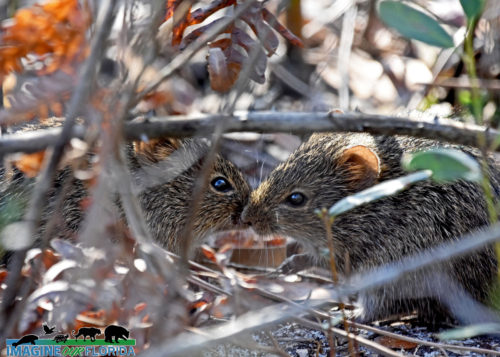The Hispid cotton rat (Sigmodon hispidus) is a species of rodent in the Cricetidae family. **The Cricetidae are a family of rodents in the large and complex superfamily Muroidea. It includes true hamsters, voles, lemmings, muskrats, and New World rats and mice. At almost 608 species, it is the second-largest family of mammals and has members throughout the Americas, Europe, and Asia. **
Hispid cotton rats are found in North and South America, including the southeastern United States, Mexico, and northern parts of South America. They inhabit a variety of habitats, including forests, fields, and wetlands. It is a medium-sized rodent with a grayish-brown coat and spiky fur on its back, which gives it its name “Hispid” meaning bristly or rough.
Description: Hispid cotton rats have short, coarse fur that is brown or grayish brown on the back and lighter on the belly. They have long, narrow tails that are sparsely haired and ears that are relatively large and round. Adults typically weigh between 50 and 100 grams and measure between 140 and 200 millimeters in total length.
Nesting and Reproduction: Hispid cotton rats build nests in burrows, hollow logs, or under thick vegetation. They are polygamous and breed throughout the year, with females giving birth to litters of 3-8 young after a gestation period of 22-27 days. The young are born hairless and helpless and are weaned at around three weeks of age.
Food: Hispid cotton rats are herbivorous and primarily feed on grasses, seeds, and other plant material. They will also eat some insects and other small animals.
Other Interesting Habits: Hispid cotton rats are primarily nocturnal and spend much of their time foraging for food. They are also good swimmers and climbers and are able to escape predators by climbing trees or diving into the water. In addition, they are known to be relatively aggressive towards other rodents and will fight to defend their territory. Hispid cotton rats play an important ecological role by providing food for predators such as snakes, owls, and other birds of prey.
The Hispid cotton rat is not currently listed as a threatened or endangered species. However, they are still an essential part of the ecosystem, and there are things we can do to help protect them and their habitat.
Some ways to help include advocating for the preservation of natural habitats, especially wetlands, which are essential to their survival. Supporting conservation efforts and raising awareness of the importance of these animals and their role in the ecosystem can also make a significant difference.
Planting native plants in your backyard or community can also help provide suitable habitat and food sources for Hispid cotton rats, as well as other native wildlife. (However as cute as they are I don’t think they would make good pets or neighbors so I’d think twice about that laugh out loud) Additionally, reducing the use of pesticides and other harmful chemicals can help protect the ecosystem and the animals that depend on it.

